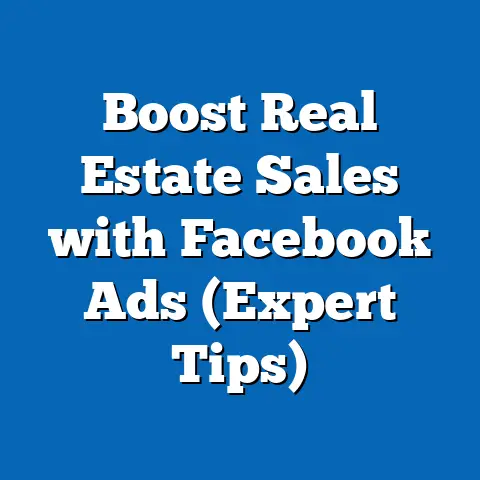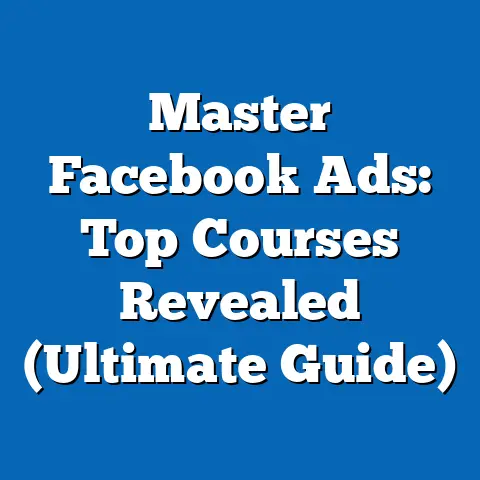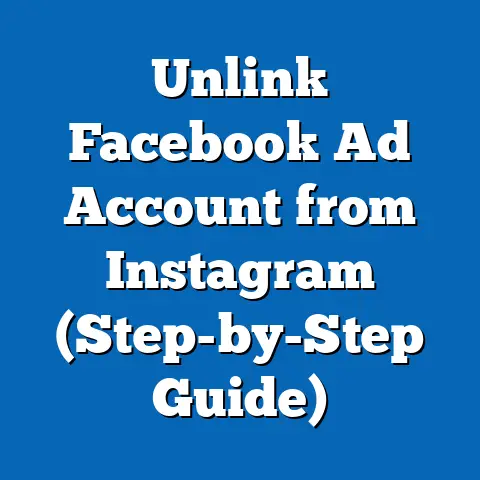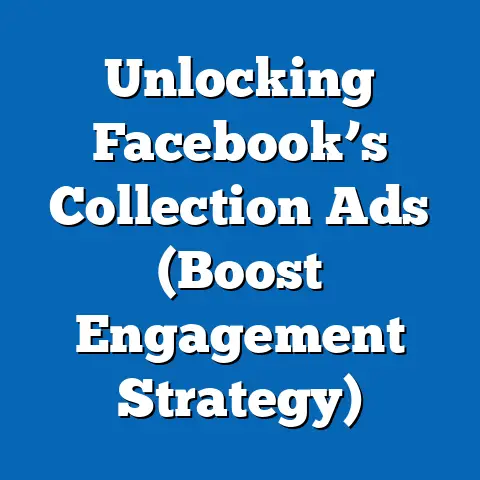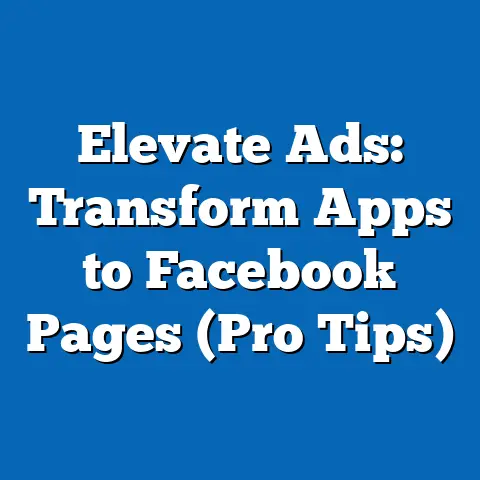Stop Wasting Budget: End Ads on Facebook (Expert Guide)
Imagine this: you’ve poured your heart and soul – not to mention a significant chunk of your budget – into crafting the perfect Facebook ad. You’ve agonized over the copy, hand-picked the most stunning visuals, and meticulously targeted your ideal audience. You launch it with excitement, envisioning a flood of new customers. But days turn into weeks, and the results are… underwhelming. The likes are scarce, shares are nonexistent, and your comments section is eerily silent. Your budget dwindles, and your ROI is nowhere to be found.
Sound familiar?
I’ve been there. I remember one particular campaign I ran for a local bakery. We had beautiful photos of their pastries, compelling copy about fresh ingredients, and laser-focused targeting on people interested in baking and desserts within a 5-mile radius. Yet, the ads flopped. It was frustrating and, frankly, a little embarrassing.
But what if I told you that you could turn this scenario around? What if you could stop throwing money down the drain on ads that simply aren’t working? What if you could learn to identify the warning signs, analyze your ad performance, and make the tough but necessary decision to pull the plug on failing campaigns?
This isn’t about admitting defeat; it’s about being a savvy marketer. It’s about understanding that effective advertising isn’t just about spending money; it’s about spending it wisely.
This article is your expert guide to understanding when and why to end your Facebook ads. I’ll walk you through the key indicators of ad failure, show you how to analyze your data, and give you the confidence to make the right decisions for your business. By the end of this guide, you’ll be equipped to ensure that your marketing efforts yield the best possible outcomes, maximizing your ROI and achieving your business goals. Let’s get started!
Understanding Facebook Ads
Facebook ads have become a cornerstone of modern marketing. Their widespread adoption stems from their immense potential reach and sophisticated targeting capabilities. With billions of active users, Facebook offers businesses unparalleled access to a diverse and engaged audience. But simply throwing an ad out there and hoping for the best is a recipe for disaster.
Facebook advertising offers a diverse range of ad formats, each designed for specific purposes and target audiences. Let’s explore some of the most common types:
- Image Ads: These are the simplest form of Facebook ads, featuring a single image or graphic with accompanying text. They are ideal for showcasing products, services, or brand messaging in a visually appealing manner.
- Video Ads: Video ads utilize motion and sound to capture attention and convey a compelling narrative. They are effective for demonstrating product features, sharing customer testimonials, or building brand awareness.
- Carousel Ads: Carousel ads display multiple images or videos within a single ad unit, allowing users to swipe through them. They are useful for showcasing a range of products, telling a story, or highlighting different aspects of a service.
- Collection Ads: Collection ads are designed for e-commerce businesses, enabling them to display a catalog of products in a visually immersive format. Users can browse products directly within the ad and click through to the website to make a purchase.
- Lead Ads: Lead ads are specifically designed to generate leads by collecting contact information from users directly within the Facebook platform. They are useful for building email lists, gathering customer feedback, or offering exclusive promotions.
- Instant Experience Ads: Instant Experience ads provide a full-screen, interactive experience that loads instantly when users click on the ad. They can incorporate images, videos, text, and interactive elements to create a highly engaging and immersive experience.
Before even thinking about ad copy or visuals, you need to define your objectives. What do you want to achieve with your Facebook ads? Common goals include:
- Brand Awareness: Increasing recognition and familiarity with your brand.
- Lead Generation: Collecting contact information from potential customers.
- Website Traffic: Driving users to your website to learn more about your products or services.
- Conversions: Encouraging users to take a specific action, such as making a purchase or filling out a form.
- App Installs: Driving downloads of your mobile app.
- Engagement: Increasing likes, shares, comments, and other interactions with your content.
Having clearly defined objectives is crucial because it allows you to track the right metrics, measure the success of your campaigns, and make informed decisions about when to end ads that aren’t contributing to your goals. Without clear objectives, you’re essentially shooting in the dark, hoping to hit something without knowing what you’re aiming for.
Takeaway: Before launching any Facebook ad campaign, clearly define your objectives. This will guide your ad creation, targeting, and performance analysis, ultimately helping you determine when to end ads that aren’t meeting your goals.
Recognizing the Signs of Ineffective Ads
So, how do you know when your Facebook ad is a dud? It’s not always obvious, and sometimes we’re so invested in our campaigns that we’re reluctant to admit they’re failing. That’s where key performance indicators (KPIs) come in. These metrics provide objective data that can help you assess the performance of your ads and identify areas for improvement.
Here are some of the most important KPIs to watch:
- Click-Through Rate (CTR): This is the percentage of people who see your ad and click on it. A low CTR indicates that your ad isn’t resonating with your target audience or that your ad creative isn’t compelling enough.
- Conversion Rate: This is the percentage of people who click on your ad and then complete a desired action, such as making a purchase or filling out a form. A low conversion rate suggests that your landing page isn’t optimized for conversions or that there’s a disconnect between your ad and your offer.
- Cost Per Acquisition (CPA): This is the amount of money you spend to acquire one customer. A high CPA indicates that your ads are not cost-effective and that you need to optimize your targeting or ad creative.
- Relevance Score: Facebook assigns each ad a relevance score based on how well it resonates with the target audience. A low relevance score indicates that your ad is not relevant to the people you’re targeting, which can lead to higher costs and lower performance.
Beyond the numbers, there are some other red flags to watch out for:
- High Spend with Low Engagement: If you’re spending a lot of money on your ads but not seeing any significant engagement (likes, shares, comments), it’s a sign that your ads aren’t capturing attention or generating interest.
- Repeatedly Low Conversion Rates: If you’ve run the same ad multiple times and consistently seen low conversion rates, it’s a clear indication that something is wrong with your ad, your landing page, or your offer.
- Audience Fatigue or Ad Blindness: Over time, your target audience may become fatigued with seeing the same ad repeatedly. This can lead to ad blindness, where people simply tune out your ads without even noticing them.
- Poor Ad Relevance Scores: As mentioned earlier, a low relevance score is a major red flag. It means that Facebook’s algorithm doesn’t think your ad is relevant to the people you’re targeting, which can significantly impact your performance.
Let me share another personal experience. I was running a campaign for an e-commerce store selling handmade jewelry. We had stunning product photos and compelling copy about the unique craftsmanship. However, after a week, the CTR was abysmal, and the conversion rate was even worse. The relevance score was hovering around 2. It was painful to watch the budget drain away with virtually no results. I knew something had to change.
I dug deeper into the data and realized that our targeting was too broad. We were targeting people interested in “jewelry” in general, but our jewelry was more niche – bohemian, handcrafted pieces. We refined our targeting to focus on people interested in specific styles and brands that aligned with our aesthetic. Within days, the CTR and conversion rate skyrocketed, and the relevance score jumped to 8.
Takeaway: Pay close attention to your KPIs and watch out for red flags. Don’t be afraid to admit when an ad isn’t working and take action to improve it or end it altogether. Remember, data is your friend!
Analyzing Your Ad Performance
Now that you know what to look for, let’s talk about how to actually analyze your ad performance. The key to effective analysis is using Facebook Ads Manager. This powerful tool provides a wealth of data and insights that can help you understand how your ads are performing and identify areas for improvement.
Here’s a step-by-step guide to analyzing your ad performance in Ads Manager:
- Set up Conversion Tracking: Before you can accurately measure your ad performance, you need to set up conversion tracking. This involves installing a Facebook Pixel on your website or app and configuring it to track specific events, such as purchases, form submissions, or page views.
- Navigate to Ads Manager: Log into your Facebook account and navigate to Ads Manager.
- Select Your Campaign, Ad Set, or Ad: Choose the campaign, ad set, or ad that you want to analyze.
- Customize Your Columns: By default, Ads Manager displays a limited set of metrics. To see the KPIs that are most important to you, click on the “Columns” dropdown menu and select “Customize Columns.”
- Choose Your Metrics: Select the metrics that you want to see in your report, such as CTR, conversion rate, CPA, relevance score, and frequency.
- Set Your Date Range: Choose the date range that you want to analyze.
- Analyze Your Data: Review the data and look for trends and patterns. Are your CTRs high or low? Are your conversion rates improving or declining? Is your CPA within your target range?
- Segment Your Data: Segment your data by demographics, placements, and devices to identify which audiences, placements, and devices are performing best.
- Use Audience Insights: Audience Insights provides valuable information about your target audience, such as their interests, demographics, and behaviors. Use this information to refine your targeting and improve the relevance of your ads.
- Evaluate Ad Placements and Formats: Experiment with different ad placements and formats to see which ones perform best for your target audience.
A/B testing, also known as split testing, is a crucial technique for pinpointing which elements of your ad are underperforming and warrant discontinuation. It involves creating two versions of an ad, each with a slight variation in one element (e.g., headline, image, call-to-action), and then running them simultaneously to see which version performs better.
For example, you could A/B test two different headlines to see which one generates a higher CTR. Or you could test two different images to see which one drives more conversions. By systematically testing different elements of your ads, you can identify what’s working and what’s not, and then make informed decisions about which ads to discontinue.
Takeaway: Master the use of Facebook Ads Manager and embrace A/B testing. These tools are essential for analyzing your ad performance, identifying areas for improvement, and making data-driven decisions about when to end ineffective ads.
The Cost of Continuing Ineffective Ads
Continuing to run ineffective ads on Facebook isn’t just a waste of money; it’s a drain on your resources, a missed opportunity, and potentially damaging to your brand. It’s like trying to drive a car with a flat tire – you’re going to get nowhere fast, and you’re likely to damage your vehicle in the process.
Let’s break down the real cost of keeping those underperforming ads running:
- Financial Implications: This is the most obvious cost. Every dollar you spend on an ad that isn’t generating results is a dollar wasted. Those dollars could be used for other marketing initiatives, product development, or even just padding your bottom line.
- Opportunity Cost: The opportunity cost is the value of what you’re giving up by choosing to continue running ineffective ads. What could you be achieving if you redirected those resources to more effective channels or strategies? Could you be running a more targeted campaign? Could you be investing in content marketing? Could you be exploring other advertising platforms?
- Brand Damage: Ineffective ads can also damage your brand. If people are repeatedly seeing ads that are irrelevant, uninteresting, or poorly designed, they may develop a negative perception of your brand. This can be especially damaging if you’re trying to build a reputation for quality and innovation.
- Wasted Time and Effort: Running ineffective ads also wastes your time and effort. You’re spending time monitoring the performance of ads that aren’t working, trying to figure out what’s wrong, and making adjustments that don’t seem to make a difference. That time could be better spent on other tasks that contribute more to your business goals.
According to a recent study by HubSpot, businesses waste an estimated 26% of their marketing budget on ineffective campaigns. That’s a staggering amount of money! Imagine what you could do with an extra 26% of your marketing budget.
I’ve witnessed firsthand the damage that wasted ad spend can inflict. I once consulted with a small business owner who was convinced that Facebook ads were a scam. He had spent thousands of dollars on ads that generated virtually no sales. He was frustrated, disillusioned, and ready to give up on Facebook advertising altogether.
After analyzing his campaigns, I quickly realized that he was making several common mistakes. He was targeting too broad of an audience, using generic ad copy, and failing to track conversions. He was essentially throwing money at the wall and hoping something would stick.
We completely revamped his strategy, focusing on laser-targeted audiences, compelling ad creative, and rigorous conversion tracking. Within weeks, his sales skyrocketed, and he became a true believer in the power of Facebook advertising.
Takeaway: Don’t underestimate the cost of continuing ineffective ads. It’s not just about the money you’re spending; it’s about the opportunities you’re missing and the potential damage to your brand. Make timely decisions to cut your losses and redirect your resources to more effective strategies.
Steps to Take After Ending Your Ads
So, you’ve analyzed your data, identified your underperforming ads, and made the tough decision to pull the plug. What’s next? The key is to treat this as a learning opportunity and use the insights you’ve gained to improve your future campaigns.
Here are some actionable steps you can take after ending your ads:
- Review and Reflect: Take some time to review the performance of the ads that you ended. What were the key factors that contributed to their failure? Was it the targeting, the ad creative, the landing page, or the offer? Be honest with yourself and identify the areas where you can improve.
- Gather Insights: Use the data you’ve collected to gain insights into your target audience, your ad creative, and your overall strategy. What did you learn about what resonates with your audience? What types of ad creative performed best? What types of offers were most effective?
- Document Your Findings: Document your findings in a central location, such as a spreadsheet or a project management tool. This will help you to remember what you’ve learned and to apply those lessons to your future campaigns.
- Brainstorm New Ideas: Use your insights to brainstorm new ideas for your next campaign. Experiment with different targeting options, ad creative, and offers. Don’t be afraid to try new things and to push the boundaries of what’s possible.
- Consider Alternative Strategies: If Facebook ads aren’t working for you, consider exploring alternative advertising strategies or platforms. Could you be more successful with Google Ads? Could you be focusing on content marketing or social media marketing? Don’t put all your eggs in one basket.
- Iterate on Future Campaigns: The most important step is to iterate on your future campaigns based on the data you’ve collected. Don’t make the same mistakes twice. Use your insights to create more effective ads, target the right audiences, and optimize your landing pages for conversions.
I remember one campaign where I ended up pausing all the ads. It was for a new line of organic baby food. I had assumed that targeting new parents would be a slam dunk, but the results were dismal. The ads were getting clicks, but the conversion rate was terrible.
After some soul-searching, I realized that my messaging was all wrong. I was focusing on the “organic” aspect of the food, but parents were more concerned about convenience and taste. I completely revamped my messaging to focus on how easy and delicious the food was, and the results were night and day.
Takeaway: Ending ineffective ads is not a failure; it’s a learning opportunity. Use the insights you’ve gained to improve your future campaigns and to develop a more effective advertising strategy. Remember, success in advertising is a marathon, not a sprint.
Conclusion
Facebook ads offer a powerful tool for businesses of all sizes to reach their target audiences and achieve their marketing goals. However, like any tool, they must be used effectively to generate the desired results. This means understanding when an ad is not performing well and having the courage to end it.
Throughout this guide, I’ve emphasized the importance of recognizing the signs of ineffective ads, analyzing your ad performance using Facebook Ads Manager, and understanding the cost of continuing ads that are not delivering results. I’ve also provided actionable steps you can take after ending your ads to learn from your mistakes and improve your future campaigns.
Remember, effective advertising is not just about spending money; it’s about spending it wisely. It’s about adopting a data-driven approach to advertising, ensuring that your budgets are used effectively to achieve your marketing goals.
I urge you to adopt a proactive approach to managing your Facebook ad campaigns. Don’t be afraid to experiment, to test new ideas, and to make tough decisions. By embracing a data-driven mindset and focusing on continuous improvement, you can maximize your ROI and achieve your business goals.
So, the next time you find yourself pouring money into ads that aren’t working, remember the lessons you’ve learned in this guide. Don’t be afraid to pull the plug, learn from your mistakes, and come back stronger than ever. Your budget – and your business – will thank you for it.

